史上最全 罗马尼亚 中英双语介绍
罗马尼亚语中有哪些与中文对应的词汇和语法
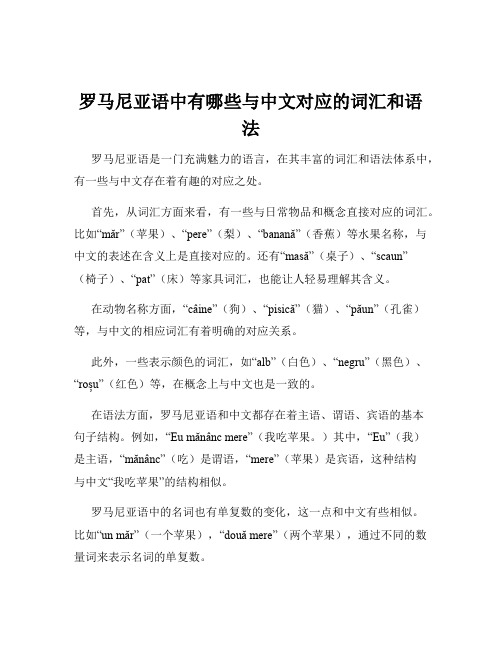
罗马尼亚语中有哪些与中文对应的词汇和语法罗马尼亚语是一门充满魅力的语言,在其丰富的词汇和语法体系中,有一些与中文存在着有趣的对应之处。
首先,从词汇方面来看,有一些与日常物品和概念直接对应的词汇。
比如“măr”(苹果)、“pere”(梨)、“banană”(香蕉)等水果名称,与中文的表述在含义上是直接对应的。
还有“masă”(桌子)、“scaun”(椅子)、“pat”(床)等家具词汇,也能让人轻易理解其含义。
在动物名称方面,“câine”(狗)、“pisică”(猫)、“păun”(孔雀)等,与中文的相应词汇有着明确的对应关系。
此外,一些表示颜色的词汇,如“alb”(白色)、“negru”(黑色)、“roșu”(红色)等,在概念上与中文也是一致的。
在语法方面,罗马尼亚语和中文都存在着主语、谓语、宾语的基本句子结构。
例如,“Eu mănânc mere”(我吃苹果。
)其中,“Eu”(我)是主语,“mănânc”(吃)是谓语,“mere”(苹果)是宾语,这种结构与中文“我吃苹果”的结构相似。
罗马尼亚语中的名词也有单复数的变化,这一点和中文有些相似。
比如“un măr”(一个苹果),“două mere”(两个苹果),通过不同的数量词来表示名词的单复数。
在动词的时态方面,罗马尼亚语和中文都有过去时、现在时和将来时的区分。
例如,“Am mâncat ieri”(我昨天吃了。
)这是过去时;“Mănânc acum”(我现在在吃。
)这是现在时;“Voi mânca mâine”(我明天吃。
)这是将来时。
不过,罗马尼亚语和中文在语法上也存在着明显的差异。
罗马尼亚语是一种屈折语,名词、形容词和动词都有丰富的词形变化。
例如,名词有性、数、格的变化,形容词要与所修饰的名词在性、数、格上保持一致。
而中文是一种分析语,主要依靠语序和虚词来表达语法关系,词形变化相对较少。
“你不知道的冷知识”罗马尼亚的那些事
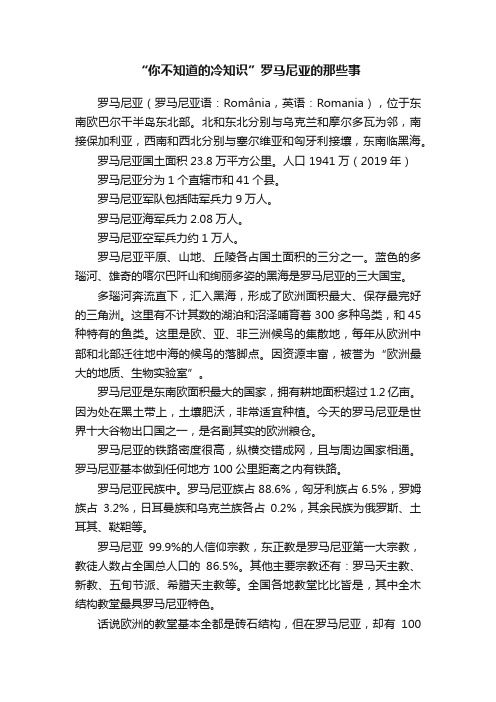
“你不知道的冷知识”罗马尼亚的那些事罗马尼亚(罗马尼亚语:România,英语:Romania),位于东南欧巴尔干半岛东北部。
北和东北分别与乌克兰和摩尔多瓦为邻,南接保加利亚,西南和西北分别与塞尔维亚和匈牙利接壤,东南临黑海。
罗马尼亚国土面积23.8万平方公里。
人口 1941万(2019年)罗马尼亚分为1个直辖市和41个县。
罗马尼亚军队包括陆军兵力9万人。
罗马尼亚海军兵力2.08万人。
罗马尼亚空军兵力约1万人。
罗马尼亚平原、山地、丘陵各占国土面积的三分之一。
蓝色的多瑙河、雄奇的喀尔巴阡山和绚丽多姿的黑海是罗马尼亚的三大国宝。
多瑙河奔流直下,汇入黑海,形成了欧洲面积最大、保存最完好的三角洲。
这里有不计其数的湖泊和沼泽哺育着300多种鸟类,和45种特有的鱼类。
这里是欧、亚、非三洲候鸟的集散地,每年从欧洲中部和北部迁往地中海的候鸟的落脚点。
因资源丰富,被誉为“欧洲最大的地质、生物实验室”。
罗马尼亚是东南欧面积最大的国家,拥有耕地面积超过1.2亿亩。
因为处在黑土带上,土壤肥沃,非常适宜种植。
今天的罗马尼亚是世界十大谷物出口国之一,是名副其实的欧洲粮仓。
罗马尼亚的铁路密度很高,纵横交错成网,且与周边国家相通。
罗马尼亚基本做到任何地方100公里距离之内有铁路。
罗马尼亚民族中。
罗马尼亚族占88.6%,匈牙利族占6.5%,罗姆族占3.2%,日耳曼族和乌克兰族各占0.2%,其余民族为俄罗斯、土耳其、鞑靼等。
罗马尼亚99.9%的人信仰宗教,东正教是罗马尼亚第一大宗教,教徒人数占全国总人口的86.5%。
其他主要宗教还有:罗马天主教、新教、五旬节派、希腊天主教等。
全国各地教堂比比皆是,其中全木结构教堂最具罗马尼亚特色。
话说欧洲的教堂基本全都是砖石结构,但在罗马尼亚,却有100多座独具特色的木教堂!据说是因为当时的匈牙利国王为了便于统治,下令禁止人们建造稳固的石头教堂用作防御。
罗马尼亚是欧盟成员国中经济增长率最高的,2019年已被世界银行列入高收入经济体行列。
史上最全 阿尔巴尼亚ALBANIA 中英双语介绍
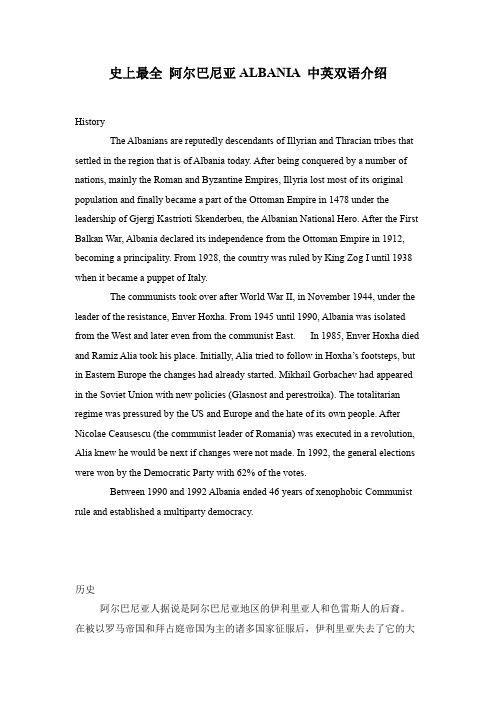
史上最全阿尔巴尼亚ALBANIA 中英双语介绍HistoryThe Albanians are reputedly descendants of Illyrian and Thracian tribes that settled in the region that is of Albania today. After being conquered by a number of nations, mainly the Roman and Byzantine Empires, Illyria lost most of its original population and finally became a part of the Ottoman Empire in 1478 under the leadership of Gjergj Kastrioti Skenderbeu, the Albanian National Hero. After the First Balkan War, Albania declared its independence from the Ottoman Empire in 1912, becoming a principality. From 1928, the country was ruled by King Zog I until 1938 when it became a puppet of Italy.The communists took over after World War II, in November 1944, under the leader of the resistance, Enver Hoxha. From 1945 until 1990, Albania was isolated from the West and later even from the communist East. In 1985, Enver Hoxha died and Ramiz Alia took his place. Initially, Alia tried to follow in Hoxha’s footsteps, but in Eastern Europe the changes had already started. Mikhail Gorbachev had appeared in the Soviet Union with new policies (Glasnost and perestroika). The totalitarian regime was pressured by the US and Europe and the hate of its own people. After Nicolae Ceausescu (the communist leader of Romania) was executed in a revolution, Alia knew he would be next if changes were not made. In 1992, the general elections were won by the Democratic Party with 62% of the votes.Between 1990 and 1992 Albania ended 46 years of xenophobic Communist rule and established a multiparty democracy.历史阿尔巴尼亚人据说是阿尔巴尼亚地区的伊利里亚人和色雷斯人的后裔。
各个国家中英文介绍
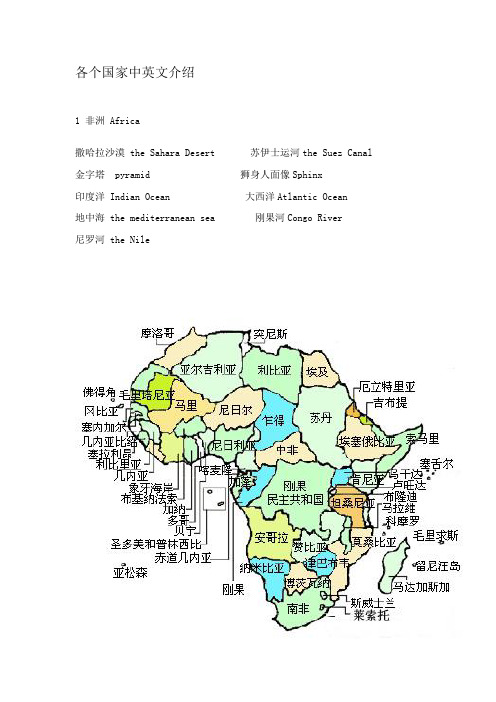
各个国家中英文介绍1 非洲 Africa撒哈拉沙漠 the Sahara Desert 苏伊士运河the Suez Canal 金字塔 pyramid 狮身人面像Sphinx印度洋 Indian Ocean 大西洋Atlantic Ocean地中海 the mediterranean sea 刚果河Congo River尼罗河 the Nile2 美洲 America太平洋 Pacific Ocean 拉丁美洲 Latin America 格陵兰岛 Greenland 北冰洋 the Arctic Ocean 墨西哥湾 the Gulf of Mexico 加勒比海 Caribbean Sea 巴拿马运河 Panama Canal3 亚洲 Asia泰姬陵 Taj Mahal 珠穆朗玛峰 Mount Qomolangma 喜马拉雅山 the Himalayas 青藏高原 tibetan plateau 道教 Taoism 佛教 Buddhism基督教 Christianity 伊斯兰教 Islam4 欧洲 Europe埃菲尔铁塔 Eiffel Tower 阿尔卑斯山 Alps欧洲各国国名及首都对照表国名首都Western Europe(7):法国 France巴黎 Paris爱尔兰 Ireland都柏林 Dublin荷兰 Netherlands阿姆斯特丹 Amsterdam比利时 Belgium布鲁塞尔Brussels卢森堡 Luxembourg卢森堡 Luxembourg英国 United Kingdom伦敦 London摩纳哥 Monaco摩纳哥 Monaco-ville Central Europe(9):波兰 Poland华沙 Warsaw瑞士 Switzerland伯尔尼 Bern列支敦士登 Liechtenstein瓦杜兹 Vaduz奥地利 Austria维也纳 Vienna匈牙利 Hungary布达佩斯 Budapest捷克 Czech布拉格 Prague斯洛伐克 Slovakia布拉提斯拉发 Bratislava 德国 Germany 柏林 Berlin斯洛文尼亚 Slovenia卢布尔雅那 Ljubljana Southern Europe(17):葡萄牙 Portugal里斯本 Lisbon西班牙 Spain马德里 Madrid安道尔 Andorra安道尔 Andorra la Vella 希腊Greece雅典 Athens意大利 Italy罗马 Rome圣马力诺 San Marino圣马力诺 San Marino马耳他 Malta斯科普里 Skopje梵蒂冈 Vatican梵蒂冈 Vatican保加利亚 Bulgaria索非亚 Sofia罗马尼亚 Romania布加勒斯特 Bucharest塞尔维亚 Serbia贝尔格莱德 Belgrade克罗地亚 Croatia萨格勒布Zagreb波斯尼亚和黑塞哥维那 Bosnia and Herzegovina萨拉热窝 Sarajevo黑山 Montenegro 波德戈里察 Podgorica阿尔巴尼亚 Albania地拉那 Tirana马其顿 Macedonia斯科普里 Skopje Northern Europe(5):丹麦Denmark哥本哈根 Copenhagen挪威 Norway奥斯陆 Oslo冰岛 Iceland雷克雅未克 Reykjavik芬兰 Finland赫尔辛基 Helsinki瑞典 Sweden斯德哥尔摩 Stockholm Eastern Europe(7):乌克兰 Ukraine基辅 kyiv俄罗斯 Russia莫斯科 Moscow白俄罗斯 Belarus明斯克 Minsk立陶宛 Lithuania维尔纽斯 Vilnius 拉脱维亚 Latvia里加 Riga爱沙尼亚 Estonia塔林 Tallinn摩尔多瓦 Moldova基希纳乌 Chisinau5 大洋洲 Oceania。
罗马尼亚用英语怎么说
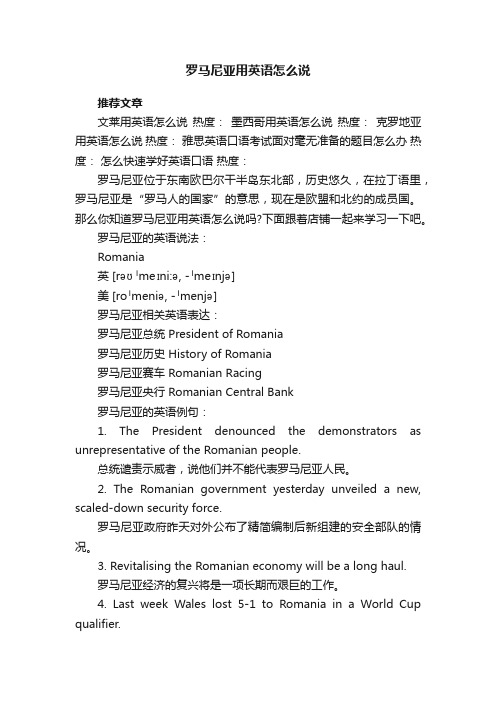
罗马尼亚用英语怎么说推荐文章文莱用英语怎么说热度:墨西哥用英语怎么说热度:克罗地亚用英语怎么说热度:雅思英语口语考试面对毫无准备的题目怎么办热度:怎么快速学好英语口语热度:罗马尼亚位于东南欧巴尔干半岛东北部,历史悠久,在拉丁语里,罗马尼亚是“罗马人的国家”的意思,现在是欧盟和北约的成员国。
那么你知道罗马尼亚用英语怎么说吗?下面跟着店铺一起来学习一下吧。
罗马尼亚的英语说法:Romania英 [rəʊˈmeɪni:ə, -ˈmeɪnjə]美 [roˈmeniə, -ˈmenjə]罗马尼亚相关英语表达:罗马尼亚总统 President of Romania罗马尼亚历史 History of Romania罗马尼亚赛车 Romanian Racing罗马尼亚央行 Romanian Central Bank罗马尼亚的英语例句:1. The President denounced the demonstrators as unrepresentative of the Romanian people.总统谴责示威者,说他们并不能代表罗马尼亚人民。
2. The Romanian government yesterday unveiled a new, scaled-down security force.罗马尼亚政府昨天对外公布了精简编制后新组建的安全部队的情况。
3. Revitalising the Romanian economy will be a long haul.罗马尼亚经济的复兴将是一项长期而艰巨的工作。
4. Last week Wales lost 5-1 to Romania in a World Cup qualifier.在上周的世界杯预选赛中,威尔士队1比5负于罗马尼亚队。
5. Romania badly needs aid to modernise its outmoded industries.罗马尼亚亟需援助以使其落后的工业现代化。
罗马尼亚移民
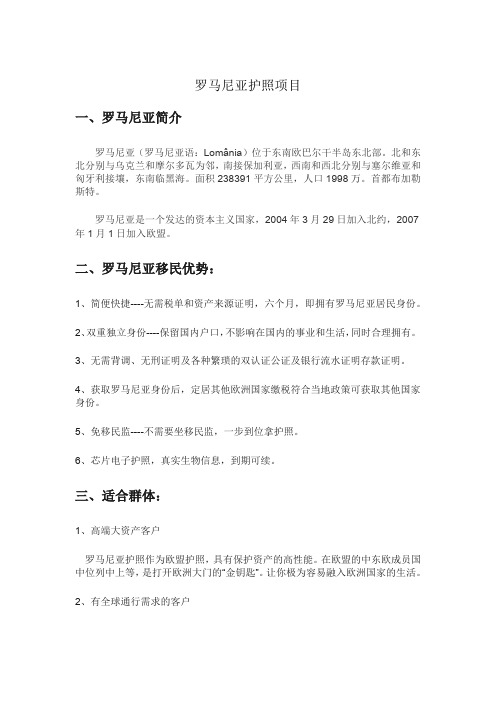
罗马尼亚护照项目一、罗马尼亚简介罗马尼亚(罗马尼亚语:Lomânia)位于东南欧巴尔干半岛东北部。
北和东北分别与乌克兰和摩尔多瓦为邻,南接保加利亚,西南和西北分别与塞尔维亚和匈牙利接壤,东南临黑海。
面积238391平方公里,人口1998万。
首都布加勒斯特。
罗马尼亚是一个发达的资本主义国家,2004年3月29日加入北约,2007年1月1日加入欧盟。
二、罗马尼亚移民优势:1、简便快捷----无需税单和资产来源证明,六个月,即拥有罗马尼亚居民身份。
2、双重独立身份----保留国内户口,不影响在国内的事业和生活,同时合理拥有。
3、无需背调、无刑证明及各种繁琐的双认证公证及银行流水证明存款证明。
4、获取罗马尼亚身份后,定居其他欧洲国家缴税符合当地政策可获取其他国家身份。
5、免移民监----不需要坐移民监,一步到位拿护照。
6、芯片电子护照,真实生物信息,到期可续。
三、适合群体:1、高端大资产客户罗马尼亚护照作为欧盟护照,具有保护资产的高性能。
在欧盟的中东欧成员国中位列中上等,是打开欧洲大门的“金钥匙”。
让你极为容易融入欧洲国家的生活。
2、有全球通行需求的客户罗马尼亚护照是欧盟护照,可以免签欧洲国家,出行150多个国家不用签证,直接免签,对于出国经商或者出国旅游者甚是方便,出行各国也是无障碍的。
3、有大国绿卡的客户大国绿卡意味着什么?意味着你不但拥有大国绿卡,也同时拥有中国国籍,美国等国家的全球征税政策意味着你交完中国的税收之后还要交绿卡国的税!这时对高资产人士来说是个头疼的问题。
如果你持有罗马尼亚护照,资产管理无疑多了一个途径,+freesky808。
4、无护照或者本国护照受限、及本人护照面临注销无法续办、及备用客户。
5、无法提供各种有效证明,不能通过背调、拿不到塞浦路斯移民资格客户。
四、所需资料:1、中国有效护照首页扫描件;2、护照版照片(电子版);3、身高、血型、眼睛颜色;4、英文签名和中文拼音签名的扫描件。
6.2.1罗马尼亚介绍

罗马尼亚介绍“一带一路”经济地理罗马尼亚介绍罗马尼亚面积为238391平方公里。
位于东南欧巴尔干半岛东北部。
东南临黑海。
地形奇特多样,境内平原、山地、丘陵各占约1/3的国土面积。
属温带大陆性气候。
罗马尼亚山河秀丽,蓝色的多瑙河、雄奇的喀尔巴阡山和绚丽多姿的黑海是罗马尼亚的三大国宝。
多瑙河流经罗境内1075公里,其国土上蜿蜒流淌的大小数百条河川,多与多瑙河汇流,形成“百川汇多瑙”的水系。
多瑙河不仅灌溉着两岸肥田沃野,也为罗的电力工业和渔业等提供了丰富的资源。
有罗马尼亚脊梁之称的喀尔巴阡山绵亘在罗40%的国土上。
这里林木茂密,森林资源丰富,地下蕴藏有煤、铁和黄金等矿产。
罗马尼亚濒临黑海,景色秀丽的黑海海滩是著名的旅游胜地。
康斯坦察是黑海海滨城市和港口,是罗通往各大洲的重要门户和全国造船业中心之一,素有“黑海明珠”之称。
罗马尼亚人的祖先是达契亚人。
约公元前1世纪,布雷比斯塔建立第一个中央集权的达契亚奴隶制国家。
公元106年达契亚国被罗马帝国征服后,达契亚人与罗马人共居融合,形成罗马尼亚民族。
1947年12月30日,罗马尼亚人民共和国成立。
1965年国名改为罗马尼亚社会主义共和国。
1989年12月易国名为罗马尼亚。
国旗:呈长方形,长与宽之比为3:2。
由三个平行相等的竖长方形组成,从左至右依次为蓝、黄、红三色。
蓝色象征蓝天,黄色象征丰富的自然资源,红色象征人民的勇敢和牺牲精神。
罗马尼亚人口2161万(2006年1月),罗马尼亚族占89.5%,匈牙利族占6.6%,罗姆族(亦称吉卜赛族)占2.5%,日耳曼族和乌克兰族各占0.3%,其余民族为俄罗斯、塞尔维亚、斯洛伐克、土耳其、鞑靼等。
城市人口所占比例为55.2%,农村人口所占比例为44.8%。
官方语言为罗马尼亚语,主要民族语言为匈牙利语。
主要宗教有东正教(信仰人数占总人口数的86.7%)、罗马天主教(5%)、新教(3.5%)和希腊天主教(1%)。
罗马尼亚主要矿藏有石油、天然气、煤和铝土矿,还有金、银、铁、锰、锑、盐、铀、铅、矿泉水等。
罗马尼亚语日常用语
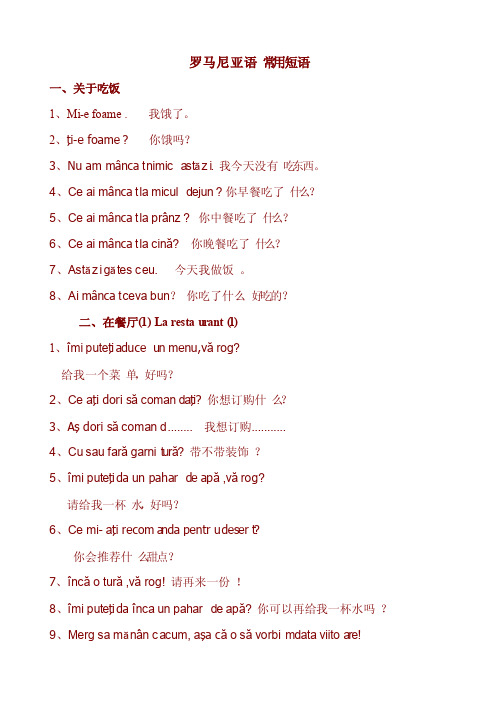
罗马尼亚语常用短语一、关于吃饭1、Mi-e foame. 我饿了。
2、ți-e foame? 你饿吗?3、Nu am mâncat nimic a stăzi. 我今天没有吃东西。
4、Ce ai mâncat la micul dejun? 你早餐吃了什么?5、Ce ai mâncat la prânz? 你中餐吃了什么?6、Ce ai mâncat la cină? 你晚餐吃了什么?7、Astăzi gătesc eu. 今天我做饭。
8、Ai mâncat ceva bun?你吃了什么好吃的?二、在餐厅(1) La restau rant(1)1、îmi puteți aduce un menu,vă rog?给我一个菜单,好吗?2、Ce ați dori să comandați? 你想订购什么?3、Aș dori să comand ........ 我想订购...........4、Cu sau fară garnit ură? 带不带装饰?5、îmi puteți da un pahar de apă ,vă rog?请给我一杯水,好吗?6、Ce mi- ați recoma nda pentru desert?你会推荐什么甜点?7、încă o tură ,vă rog! 请再来一份!8、îmi puteți da înca un pahar de apă? 你可以再给我一杯水吗?9、Merg sa mănânc acum, așa că o să vorbim data viitoa re!现在去吃饭,所以我们下一次再讨论。
10、Care este mâncar ea ta favorită? 你最喜欢的食物是什么?11、Mâncar ea mea favorită este ....... 我最喜欢的食物是......三、在医生那里 L a doctor1、Aș putea să-l văd pe doctor, vă rog?我可以见医生吗?2、Vă rog, chemați un doctor repede!请你赶快叫一个医生!3、Vă rog,aduceți un doctor. 请带来一个医生。
欧洲国家中英文对照带音标
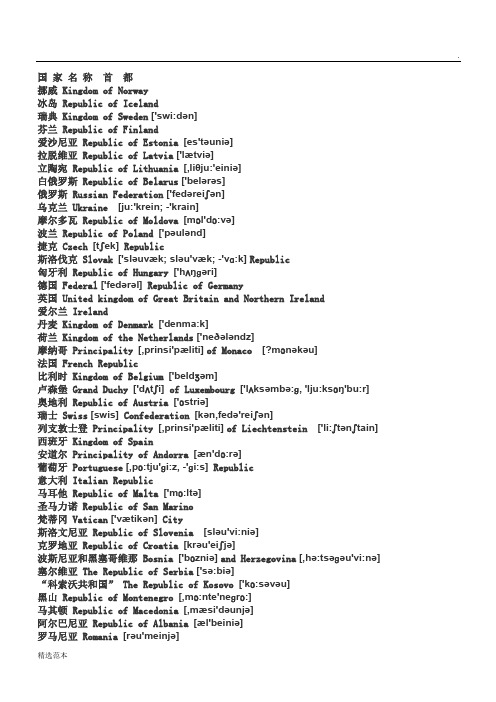
国家名称首都挪威 Kingdom of Norway冰岛 Republic of Iceland瑞典 Kingdom of Sweden ['swi:dən]芬兰 Republic of Finland爱沙尼亚 Republic of Estonia [es'təuniə]拉脱维亚 Republic of Latvia ['lætviə]立陶宛 Republic of Lithuania [,liθju:'einiə]白俄罗斯 Republic of Belarus ['belərəs]俄罗斯 Russian Federation ['fedəreiʃən]乌克兰 Ukraine [ju:'krein; -'krain]摩尔多瓦 Republic of Moldova [mɔl'dɔ:və]波兰 Republic of Poland ['pəulənd]捷克 Czech [tʃek] Republic斯洛伐克 Slovak ['sləuvæk; sləu'væk; -'vɑ:k] Republic匈牙利 Republic of Hungary ['hʌŋɡəri]德国 Federal ['fedərəl] Republic of Germany英国 United kingdom of Great Britain and Northern Ireland爱尔兰 Ireland丹麦 Kingdom of Denmark ['denma:k]荷兰 Kingdom of the Netherlands ['neðələndz]摩纳哥 Principality [,prinsi'pæliti] of Monaco [?mɔnəkəu]法国 French Republic比利时 Kingdom of Belgium ['beldʒəm]卢森堡 Grand Duchy ['dʌtʃi] of Luxembourg ['lʌksəmbə:ɡ, 'lju:ksɔŋ'bu:r]奥地利 Republic of Austria ['ɔstriə]瑞士 Swiss [swis] Confederation [kən,fedə'reiʃən]列支敦士登 Principality [,prinsi'pæliti] of Liechtenstein ['li:ʃtənʃtain]西班牙 Kingdom of Spain安道尔 Principality of Andorra [æn'dɔ:rə]葡萄牙 Portuguese [,pɔ:tju'ɡi:z, -'ɡi:s] Republic意大利 Italian Republic马耳他 Republic of Malta ['mɔ:ltə]圣马力诺 Republic of San Marino梵蒂冈 Vatican ['vætikən] City斯洛文尼亚 Republic of Slovenia [sləu'vi:niə]克罗地亚 Republic of Croatia [krəu'eiʃjə]波斯尼亚和黑塞哥维那 Bosnia ['bɔzniə] and Herzegovina [,hə:tsəɡəu'vi:nə]塞尔维亚 The Republic of Serbia ['sə:biə]“科索沃共和国” The Republic of Kosovo ['kɔ:səvəu]黑山 Republic of Montenegro [,mɔ:nte'neɡrɔ:]马其顿 Republic of Macedonia [,mæsi'dəunjə]阿尔巴尼亚 Republic of Albania [æl'beiniə]罗马尼亚 Romania [rəu'meinjə]保加利亚 Republic of Bulgaria [bʌl'ɡεəriə]希腊 Hellenic [he'lenik, Republic法罗群岛(丹) Faroe Islands。
史上最全 Slovenia斯洛文尼亚 中英双语介绍
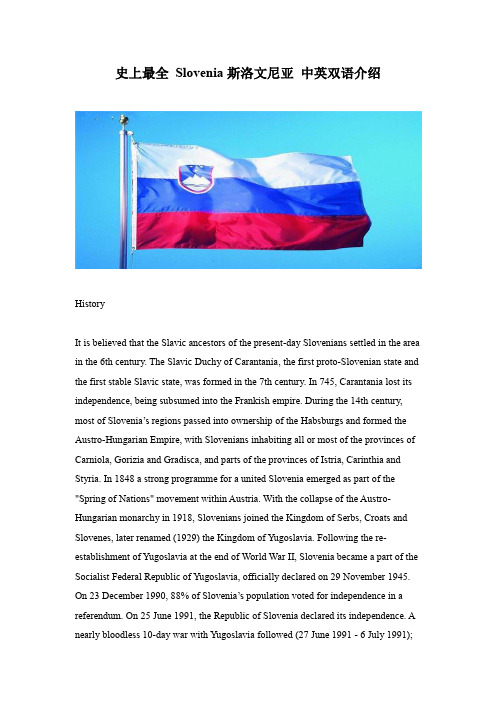
史上最全Slovenia斯洛文尼亚中英双语介绍HistoryIt is believed that the Slavic ancestors of the present-day Slovenians settled in the area in the 6th century. The Slavic Duchy of Carantania, the first proto-Slovenian state and the first stable Slavic state, was formed in the 7th century. In 745, Carantania lost its independence, being subsumed into the Frankish empire. During the 14th century, most of Slovenia’s regions passed into ownership of the Habsburgs and formed the Austro-Hungarian Empire, with Slovenians inhabiting all or most of the provinces of Carniola, Gorizia and Gradisca, and parts of the provinces of Istria, Carinthia and Styria. In 1848 a strong programme for a united Slovenia emerged as part of the "Spring of Nations" movement within Austria. With the collapse of the Austro-Hungarian monarchy in 1918, Slovenians joined the Kingdom of Serbs, Croats and Slovenes, later renamed (1929) the Kingdom of Yugoslavia. Following the re-establishment of Yugoslavia at the end of World War II, Slovenia became a part of the Socialist Federal Republic of Yugoslavia, officially declared on 29 November 1945. On 23 December 1990, 88% of Slovenia’s population voted for independence in a referendum. On 25 June 1991, the Republic of Slovenia declared its independence. A nearly bloodless 10-day war with Yugoslavia followed (27 June 1991 - 6 July 1991);Yugoslav People’s Army forces withdrew after Slovenia demonstrated stiff resistance to Belgrade. Slovenia joined NATO on 29 March 2004 and the European Union on 1 May 2004.历史现今的斯洛文尼亚人的祖先拉斯夫人在6世纪时迁移到斯洛文尼亚。
罗马尼亚语简介
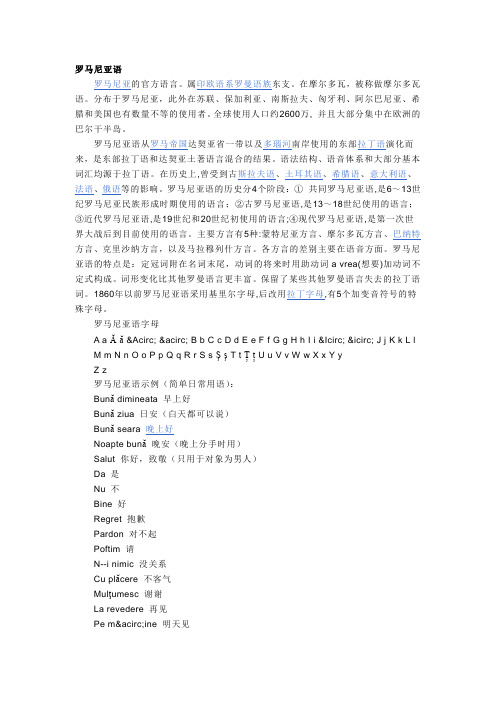
罗马尼亚语罗马尼亚的官方语言。
属印欧语系罗曼语族东支。
在摩尔多瓦,被称做摩尔多瓦语。
分布于罗马尼亚,此外在苏联、保加利亚、南斯拉夫、匈牙利、阿尔巴尼亚、希腊和美国也有数量不等的使用者。
全球使用人口约2600万, 并且大部分集中在欧洲的巴尔干半岛。
罗马尼亚语从罗马帝国达契亚省一带以及多瑙河南岸使用的东部拉丁语演化而来,是东部拉丁语和达契亚土著语言混合的结果。
语法结构、语音体系和大部分基本词汇均源于拉丁语。
在历史上,曾受到古斯拉夫语、土耳其语、希腊语、意大利语、法语、俄语等的影响。
罗马尼亚语的历史分4个阶段:①共同罗马尼亚语,是6~13世纪罗马尼亚民族形成时期使用的语言;②古罗马尼亚语,是13~18世纪使用的语言;③近代罗马尼亚语,是19世纪和20世纪初使用的语言;④现代罗马尼亚语,是第一次世界大战后到目前使用的语言。
主要方言有5种:蒙特尼亚方言、摩尔多瓦方言、巴纳特方言、克里沙纳方言,以及马拉穆列什方言。
各方言的差别主要在语音方面。
罗马尼亚语的特点是:定冠词附在名词末尾,动词的将来时用助动词a vrea(想要)加动词不定式构成。
词形变化比其他罗曼语言更丰富。
保留了某些其他罗曼语言失去的拉丁语词。
1860年以前罗马尼亚语采用基里尔字母,后改用拉丁字母,有5个加变音符号的特殊字母。
罗马尼亚语字母A a Ăă Â âB bC cD dE eF fG gH hI i Î îJ jK kL lM m N n O o P p Q q R r S s Șș T t Țț U u V v W w X x Y yZ z罗马尼亚语示例(简单日常用语):Bună dimineata 早上好Bună ziua 日安(白天都可以说)Bună seara 晚上好Noapte bună晚安(晚上分手时用)Salut 你好,致敬(只用于对象为男人)Da 是Nu 不Bine 好Regret 抱歉Pardon 对不起Poftim 请N--i nimic 没关系Cu plăcere 不客气Mulţumesc 谢谢La revedere 再见Pe mâine 明天见Cine? 谁?Ce? 什么?Care? 哪个?Unde? 哪里?Când? 什么时候?Pe ce? 为什么?Cum? 怎么样?La revedere 再见Bună你好Sa ai o zi bună祝你愉快Bună seara 晚上好Bună嗨!Cum te numesti? 你叫什么?Numele meu este 我叫.......Domnişoara 小姐风俗与法规:罗马尼亚人主要信奉东正教。
罗马尼亚简介

● 16世纪后成为奥斯曼帝国的附属国。
● 1848年,瓦拉几亚和摩尔多瓦两国爆发了民族民主革命。
● 1856年,沙俄在克里木战争中败北,《巴黎和约》(1856)取消了沙俄对罗马尼亚的“保护”, 代之以欧洲七强(法、英、奥、俄、土、普、撒丁)的共同“保护”,消除了俄国对两公国的长 期控制,也在一定程度上削弱了土耳其的宗主国权力。允许两公国各自选举本国议会,由议会主 持产生选民大会以选举未来的君主。
希腊天主教(0.8%)。
风俗
● 罗马尼亚人为罗马人和达契亚人的后代,热情、豪爽、待人随和,喜欢交朋友,交谈时喜欢直截 了当。尊重女士,男士进门、上车要让女士先行,下楼梯时男子则在前护卫。亲友间见面拥抱、 贴面很普遍。应邀作客时需向女士送鲜花,赠花总数应为单数,但不是13朵。
● 罗马尼亚人视盐和面包为生活中必不可少的食物。客人到来,最隆重的礼节是由主人家的姑娘托 着盘子向客人送上面包和盐,客人需拿一块面包蘸盐尝一下。早餐较简单,晚餐很丰盛,讲究质 好量多,请客吃饭时间较长,宴会通常约持续2-3小时。出席正式晚宴时,男士一般着深色西服, 女士着裙装。
地理知识:世界各国介绍-罗马尼亚(欧洲)
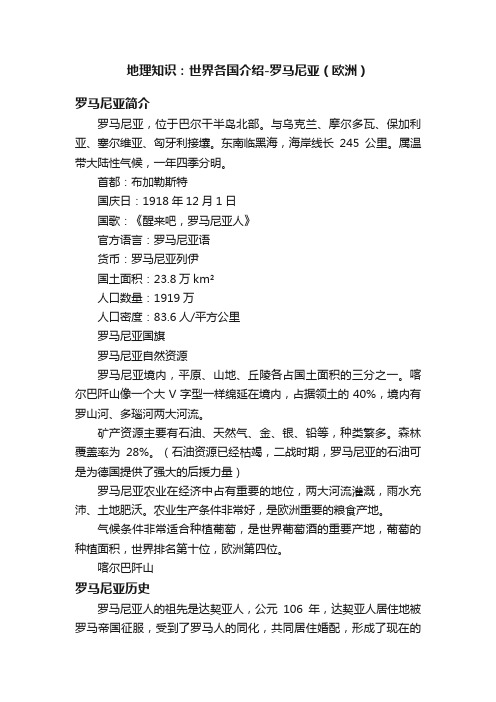
地理知识:世界各国介绍-罗马尼亚(欧洲)罗马尼亚简介罗马尼亚,位于巴尔干半岛北部。
与乌克兰、摩尔多瓦、保加利亚、塞尔维亚、匈牙利接壤。
东南临黑海,海岸线长245公里。
属温带大陆性气候,一年四季分明。
首都:布加勒斯特国庆日:1918年12月1日国歌:《醒来吧,罗马尼亚人》官方语言:罗马尼亚语货币:罗马尼亚列伊国土面积:23.8万km²人口数量:1919万人口密度:83.6人/平方公里罗马尼亚国旗罗马尼亚自然资源罗马尼亚境内,平原、山地、丘陵各占国土面积的三分之一。
喀尔巴阡山像一个大V字型一样绵延在境内,占据领土的40%,境内有罗山河、多瑙河两大河流。
矿产资源主要有石油、天然气、金、银、铅等,种类繁多。
森林覆盖率为28%。
(石油资源已经枯竭,二战时期,罗马尼亚的石油可是为德国提供了强大的后援力量)罗马尼亚农业在经济中占有重要的地位,两大河流灌溉,雨水充沛、土地肥沃。
农业生产条件非常好,是欧洲重要的粮食产地。
气候条件非常适合种植葡萄,是世界葡萄酒的重要产地,葡萄的种植面积,世界排名第十位,欧洲第四位。
喀尔巴阡山罗马尼亚历史罗马尼亚人的祖先是达契亚人,公元106年,达契亚人居住地被罗马帝国征服,受到了罗马人的同化,共同居住婚配,形成了现在的罗马尼亚人。
可以说,罗马尼亚人是达契亚人和罗马人的后裔。
1918年12月1日,特兰西瓦尼亚公国与罗马尼亚王国合并,罗马尼亚成立。
齐奥塞斯库时期相信年龄大一点的都知道齐奥塞斯库这个人吧,曾经是社会主义阵营的一员。
1965年在当选为罗马尼亚工人党第一书记后,将工人党改为了共产党。
上台初期,齐奥塞斯库极力平反过去的冤假错案,发扬民主精神,大力发展经济,改善人民的生活条件。
赢得了人民的信任和支持,也树立了自己的威望。
随着自己地位的巩固,齐奥塞斯库有点飘飘然了,所有集权都牢牢把握在手心了,能自己兼任的,绝不劳别人的大驾,成了一个妥妥的兼职王者。
齐奥塞斯库全国各地挂满了他的巨型画像。
罗马尼亚字母表
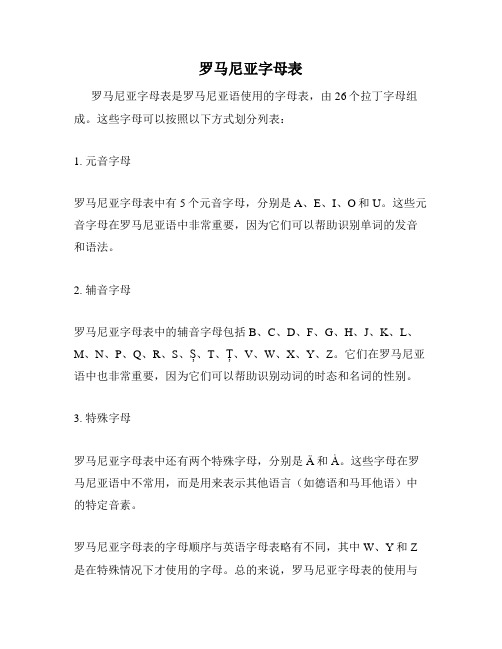
罗马尼亚字母表
罗马尼亚字母表是罗马尼亚语使用的字母表,由26个拉丁字母组成。
这些字母可以按照以下方式划分列表:
1. 元音字母
罗马尼亚字母表中有5个元音字母,分别是A、E、I、O和U。
这些元音字母在罗马尼亚语中非常重要,因为它们可以帮助识别单词的发音和语法。
2. 辅音字母
罗马尼亚字母表中的辅音字母包括B、C、D、F、G、H、J、K、L、M、N、P、Q、R、S、Ș、T、Ț、V、W、X、Y、Z。
它们在罗马尼亚语中也非常重要,因为它们可以帮助识别动词的时态和名词的性别。
3. 特殊字母
罗马尼亚字母表中还有两个特殊字母,分别是Ä和Ȧ。
这些字母在罗马尼亚语中不常用,而是用来表示其他语言(如德语和马耳他语)中的特定音素。
罗马尼亚字母表的字母顺序与英语字母表略有不同,其中W、Y和Z 是在特殊情况下才使用的字母。
总的来说,罗马尼亚字母表的使用与
英语字母表相似,但是由于罗马尼亚语的独特特征,它们在语言中的作用和意义可能会略有不同。
罗马尼亚简介
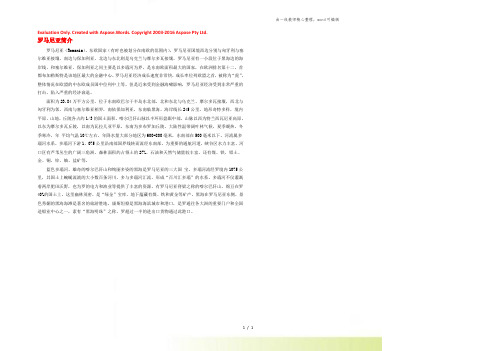
由一线教师精心整理,word可编辑Evaluation Only. Created with Aspose.Words. Copyright 2003-2016 Aspose Pty Ltd.罗马尼亚简介罗马尼亚(Romania),东欧国家(有时也被划分在南欧的范围内)。
罗马尼亚国境西边分别与匈牙利与塞尔维亚接壤,南边与保加利亚,北边与东北则是乌克兰与摩尔多瓦接壤。
罗马尼亚有一小段位于黑海边的海岸线,和塞尔维亚、保加利亚之间主要是以多瑙河为界,是东南欧面积最大的国家,在欧洲排名第十二。
首都布加勒斯特是该地区最大的金融中心。
罗马尼亚经济成长速度非常快,成长率位列欧盟之首,被称为“虎”,整体情况在欧盟的中东欧成员国中位列中上等。
但是近来受到金融海啸影响,罗马尼亚经济受到非常严重的打击,陷入严重的经济衰退。
面积为23.84万平方公里。
位于东南欧巴尔干半岛东北部。
北和东北与乌克兰、摩尔多瓦接壤,西北与匈牙利为邻,西南与塞尔维亚相界,南依保加利亚,东南临黑海。
海岸线长245公里。
地形奇特多样,境内平原、山地、丘陵各占约1/3的国土面积。
喀尔巴阡山脉以半环形盘踞中部,山脉以西为特兰西瓦尼亚高原,以东为摩尔多瓦丘陵,以南为瓦拉几亚平原,东南为多布罗加丘陵。
大陆性温带阔叶林气候,夏季暖热,冬季寒冷,年平均气温10℃左右,年降水量大部分地区为600-800毫米,东南部在500毫米以下。
河流属多瑙河水系,多瑙河下游1,075公里沿南部国界线转而流经东南部,为重要的通航河道,峡谷区水力丰富,河口区有芦苇丛生的广阔三角洲。
森林面积约占领土的27%。
石油和天然气储量较丰富,还有煤、铁、铝土、金、铜、锌、铀、盐矿等。
蓝色多瑙河、雄奇的喀尔巴阡山和绚丽多姿的黑海是罗马尼亚的三大国宝。
多瑙河流经罗境内1075公里,其国土上蜿蜒流淌的大小数百条河川,多与多瑙河汇流,形成“百川汇多瑙”的水系。
多瑙河不仅灌溉着两岸肥田沃野,也为罗的电力和渔业等提供了丰富的资源。
罗马尼亚介绍

体育
昔日世界体操霸主之一的罗马尼亚体操队,如今却面临巨大危机。由 於政府投入不足,很多名将和教练退役或移居海外,这个东欧体操王 国逐渐衰落。在北京奥运会开幕前夕,罗马尼亚政府多管齐下,激励 队员们赛出佳绩。 很多爱看体操比赛的人都对科马内奇印象深刻,她是罗马尼亚体 操史上最优秀的运动员,曾在1976年奥运会上夺得3块金牌,是奥运 会歷史上第一个得到满分10分的体操运动员。她代表了罗马尼亚体操 最辉煌的时代。 在上一届奥运会上,罗马尼亚队赢得了6块奖牌,在过去50年中, 他们共获得了超过50块奖牌。自1976年以来,该国女子体操队每年都 获得团体奖牌。然而现在,女子体操队已经缺乏能够在北京奥运会上 让裁判和观眾眼前一亮的选手。 罗马尼亚国家女队教练弗明特近日表示,“罗马尼亚体操正陷入 危机,没有高水準运动员,没有足够的医疗支援,后备人才不断萎缩, 那个人人都希望成為下一个科马内奇的时代已经过去了”。
国家介绍 罗马尼亚
姓名:
国旗
罗马尼亚是由摩达维亚与瓦拉几亚两公国 合并而成的,国旗即是以两国国旗的色彩 融合而成。蓝色是摩达维亚,黄色是瓦拉 几亚,红色则是双方共同的顏色,象徵团 结一致。
国花 狗蔷薇
醒来吧,罗马尼亚人,从 死一样的沉睡中 从野蛮暴君的压迫中 就在现在建立新的命运 在这命运面前即使是最残 酷的敌人也会屈服. 就在现在让我们给世界证 明 我们的手中仍然流著罗马 人的血, 我们的心中仍然為一个人 骄傲 为英勇得胜的特拉扬骄傲。 看吧,那些伟人的幽灵们, 米哈伊,史帝凡,科尔文 内
历史
罗马尼亚人的祖先为达契亚人。 约西元前1世纪,佈雷比斯塔建立了第一个中央集 权和独立的达契亚奴隶制国家。 西元106年达契亚国被罗马帝国征服后,达契亚人 与罗马人共居融合,形成罗马尼亚民族,并先后 组成瓦拉几亚、摩尔多瓦和特兰西瓦尼亚三个政 治结构。 14世纪时建立了瓦拉几亚和摩尔多瓦两个封建公 国。 16世纪后成為鄂图曼土耳其帝国的附属国。
- 1、下载文档前请自行甄别文档内容的完整性,平台不提供额外的编辑、内容补充、找答案等附加服务。
- 2、"仅部分预览"的文档,不可在线预览部分如存在完整性等问题,可反馈申请退款(可完整预览的文档不适用该条件!)。
- 3、如文档侵犯您的权益,请联系客服反馈,我们会尽快为您处理(人工客服工作时间:9:00-18:30)。
史上最全罗马尼亚中英双语介绍HistoryThe principalities of Wallachia and Moldavia - for centuries under the suzerainty of the Turkish Ottoman Empire - secured their autonomy in 1856; they united in 1859 and a few years later adopted the new name of Romania. The country gained recognition of its independence in 1878 from the great powers following the Russo-Turkish war. However, during the Austria-Hungary (1867C1918), Romanians in Transylvania (Western and Central parts of today Romania) experienced one of the worst periods of oppression in their history in the form of Hungarianisation.In spite of its previous alliance with Germany and Austria, Romania joined the Allied Powers in World War I in a move aimed at acquiring Transylvania. At the end of the World War I, which brought the disintegration of the empires of Russia and Austria-Hungary, Bessarabia (eastern part of today Moldova) and Transylvania united with the Romanian Kingdom in 1918. Union of Transylvania with Romania was ratified in 1920.In 1940, Romania allied with the Axis powers and participated in the 1941 German invasion of the USSR. Three years later, Romania was overrun by the Soviets and signed an armistice. The post-war Soviet occupation led to the formation of aCommunist "people"s republic" in 1947 and the abdication of the king. The decades-long rule of dictator Nicolae Ceausescu, who took power in 1965, and his Securitate police state became increasingly oppressive and draconian through the 1980s. Ceausescu was overthrown and executed in late 1989. Former Communists dominated the government until 1996, when they were swept from power by a fractious coalition of centrist parties.Rania joined NATO in March 2004.历史瓦拉几亚和摩尔达维亚侯国在被土耳其奥托曼帝国统治了几个世纪后,于1856年恢复自治,他们在1859年结成联盟,几年后采用了罗马尼亚这个新的国名。
在俄国-土耳其战争后,罗马尼亚的独立被超级强国承认。
然而,在奥匈帝国时期(1867-1918年),特兰西瓦尼亚的罗马尼亚人(今天罗马尼亚的中西部)受匈牙利同化而经历其历史上最压迫的阶段。
尽管以前曾与德国及奥地利亚结盟,为了夺回特兰西瓦尼亚,罗马尼亚在第一次世界大战时加入了同盟国。
在一战结束时,随着俄罗斯和奥匈帝国的瓦解,比萨拉比亚(今天摩尔多瓦的东部)和特兰西瓦尼在1918年与罗马尼亚王国结盟。
1920年,特兰西瓦尼亚与罗马尼亚的结盟被批准。
1940年,罗马尼亚加入轴心国,参加了1941年德国入侵苏联的战争。
三年后,罗马尼亚被前苏联入侵,并签署了休战协议。
1947年在战后苏联占领的地区成立了共产主义人民共和国,并导致了王国的瓦解。
1965年,Nicolae Ceausescu掌权,他长达几十年的独裁统治和他设立的警察机关使国家在整个八十年代处于沉重和严峻的状态下。
1989年末Ceausescu被推翻并处被处死。
前共产党执政, 直到1996年, 被合并的中间派党推翻。
2004年3月罗马尼亚加入北大西洋公约组织。
GeographyRomania is situated in southeastern Europe, bordered by Ukraine and Moldova in the northeast; Hungary in the west; Serbia and Bulgaria to the south along the Danube River. Romania has a stretch of sea coast on the Black Sea and the eastern and southern Carpathian mountains run through its centre.A large part of Romania’s borders with Serbia and Bulgaria is formed by the Danube. The Danube is joined by the Prut River, which forms the border with Moldova. The Danube flows into the Black Sea forming the Danube Delta which is a reservation of the Biosphere. Many Romania’s borders are defined by natural, sometimes shifting rivers, and because the Danube Delta is constantly expanding towards the sea, about 2-5 linear metres yearly, Romania’s surface area has changed over the past few decades, generally increasing. The number has increased from about 237,500 km² in 1969 to 238,391 km² in 2005. The Carpathian Mountains dominate the centre of Romania surrounding the Transylvanian Plateau, 14 peaks reaching above the altitude of 2,000 m, the highest being Moldoveanu Peak at 2,544 m. In the south, the Carpathians sweeten into hills, towards the Bărăgan Plains.地理罗马尼亚位于欧洲东南部,东北面和乌克兰及摩尔多瓦接壤,西面和匈牙利接壤,南面隔着多瑙河的是塞尔维亚和保加利亚。
罗马尼亚在黑海沿岸有很长的海岸线,东面和南面的喀尔巴阡山脉(Carpathian) 贯穿国家中心。
罗马尼亚和塞尔维亚及保加利亚的边界大部分是多瑙河。
多瑙河的支流普鲁特河,形成了河摩尔多瓦的边界。
多瑙河流入黑海,形成保护生物圈的多瑙河三角洲。
罗马尼亚的许多边界都是由自然或时常迁移的河流形成的,由于多瑙河三角洲以每年2-5米的速度不断向海洋延伸,在过去的几十年间,罗马尼亚的表面面积不断增长着。
其面积从1969年的23.75万平方公里增长到2005年的23.8391平方公里。
喀尔巴阡山脉俯瞰罗马尼亚中部的特兰西瓦尼亚(Transylvanian) 高原。
14座高峰海拔达到2000米,最高峰为Moldeveanu,海拔2544米。
在南部,喀尔巴阡山脉山脉形成的小山丘,接近于Baragan Plain。
Political SystemRomania is a democratic republic. The legislative branch of the Romanian government consists of two chambers, the Senat (Senate), which has 137 members (as of 2005), and the Camera Deputaţilor (Chamber of Deputies), which has 332 members (as of 2004). The members of both chambers are elected every four years.The President, the head of the executive branch, is also elected by popular vote, every five years (until 2005, four years). The president appoints a prime minister, whoheads the government, the members of which are in turn appointed by the prime minister. The government is subject to a parliamentary vote of approval.政治体系罗马尼亚是民主共和国。
